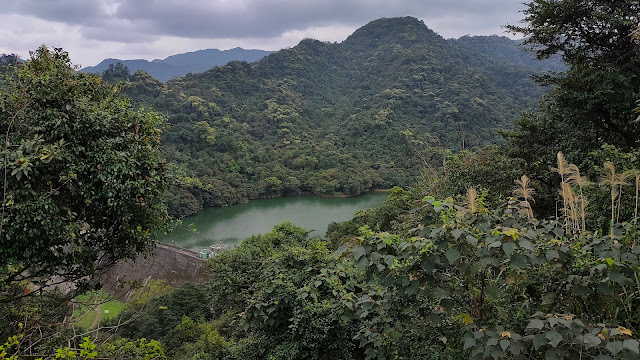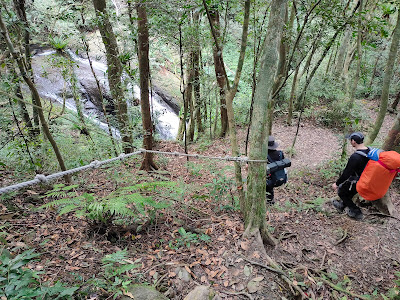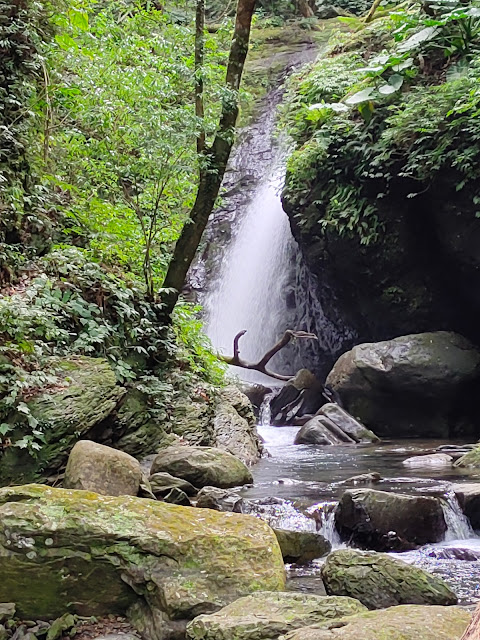 |
| Hiking along the Xishi Stream |
Luxuriant jungle-like forest, a beautiful, swift-flowing stream with many deep pools and a path around a large placid reservoir. This route starts at a park in Nuandong Valley, climbs a small peak, then drops down to follow the Xishi stream all the way to the Xishi Reservoir before finishing at Nuannuan Train Station. This was a new hike for me and one of my favorites so far this year. It is also convenient to get to from Taipei.
Distance/Time: 8.4 km/ 6 hours and 24 minutes
The Trail: The trail starts out in a manicured park with wide paths but soon leaves it behind for wilder paths. The trail was in good shape and there were signs that some pretty heavy duty trail maintenance had taken place. The footing was mostly good but some parts were slow going because of slippery rocks and scrambling over boulders. It was not steep overall or strenuous but there were many short steep sections both up and down and enough places where we had to use both hands and feet to make it really interesting.
Overall I think this trail falls somewhere between a moderate hike and a hard hike. There are plenty of rough sections but its not too hard. However, inexperienced hikers might find some parts daunting. There were lots of shallow stream crossings. I would probably avoid this hike after heavy rain. The beauty of the forest and the stream and the variety of scenery made it a really enjoyable walk.
What to bring: I packed water and lots of snacks. The trail was mostly in shade but there were also quite a few sunny sections so sunscreen and a hat are recommended on hot days. There were lots of shallow stream crossings so water proof boots are a plus as well as a hiking pole for helping to balance on rocks when crossing.
Transportation: This hike is easy to get to. There were three people in our group. We met at Taipei Main Station and took a train to Nuannuan Station which took about 40 minutes and cost NT$38.
From Nuannuan Station I thought that we could take bus 603 to the Nuandong Valley Park. However, every time I checked the bus tracker app it did not show a bus approaching the station and when we got to the bus stop there was a group of women who told us they had been waiting for a long time. The sign at the bus stop said the bus came at 8:50 but when 8:50 had come and gone we opted to take a taxi. It was about a ten minute ride and only cost NT$150.
On the way back we walked all the way to the train station and only had to wait about 30 minutes for a train back to Taipei.
The Hike:
I read about this trail last summer on the Taipei Hiker blog and since then have been looking for an opportunity to walk it. You can read the Taipei Hiker blog post about this trail here: https://taipeihiker.blogspot.com/2021/07/2021717-hiking-over-small-peak-and.html
Below is my own experience walking almost the same route--though we went a different way near the end.
We got out of the taxi at the Nuandong Valley Park parking lot. There were toilets to the right and a wooden shelter house with benches to the left. We were ready to go but after getting our bearings, noticed there was a metal construction fence blocking the park entrance.
After debating for a few minutes we decided there was no other way around. So we waited until no one seemed to be looking and climbed over the faux-bamboo railing on the side and went in.
There was no one inside and anyway within a few hundred meters we were out of the park and onto the trail. We crossed a stream over a wide bridge, and passed another bridge on the left . We went straight ahead past a wooden building and came to a map board, and a little further on, the trail head.
 |
| Flags in the trees on the right mark the trailhead |
The narrow dirt path climbed gently through shady forest.
In about three hundred meters we came to the first stream crossing--across large boulders with a rope to help keep balance.
And very shortly came to a T-junction. The path on the left heads back toward the park. We went right and uphill.
The trail also passed through groves of bamboo and in about 450 meters (30 minutes after we started walking) we came to another junction. We went right and soon crossed back over the stream.
From here the path went up more steeply.
We passed some old stone walls and the remains of indigo extraction pits. They are mentioned in the Taipei Hikers blog and the guide of a group of hikers we met later was also telling his group about them. Indigo (the guide called it malan 馬藍) has a purplish funnel shaped blossom. The leaves and stems were once harvested and used for producing blue dye.
The plant was introduced to Taiwan from China during the Qing Dynasty. The indigo dye industry declined during Japanese colonial rule though it did continue among some residents who did not have access to or did not want to pay for imported dyes. However, after World War I the industry was pretty much completely gone.
This article in Chinese is very informative and has excellent photos of the plant. My Chinese is not good enough to read it in Chinese but translated using Google, it's very readable. https://teia.tw/natural_valley_star/ph2021-12-01/
In another 500 meters we came to a four way intersection. The path ahead and down hill was the way we would later take but first we went right and climbed to the summit of Dong Shi Da Lun (455 m). The path to the top was very narrow and steep in some places. It was a fun short climb.
We reached the top at 10:35-- so just about an hour after we started walking. There was a large hiking group already there, all of its members wearing identical red shirts.
Some of the members at the back of the group told us there was a friend from Scotland with them. The crowd parted and he came over to talk to us. We exchanged greetings and identified our respective countries of origin and took a picture together.
After a few minutes the group started to move on. They were heading straight ahead. Also going to the reservoir but by a high route that goes over two more summits. We saw them again later at the end. My guess is that this is the more popular route. I would like to try it another day, however, our plan was to drop down and follow the stream to the reservoir.
We went back down to the intersection below and at the junction went right and downhill.
It went down sometimes steeply but sometimes leveling off.
At times the path was a little unclear and there were branches fallen across the way but we just kept an eye out for the flags.
Eventually we joined a rocky ravine and the path sometimes followed it and sometimes went across it or climbed above it to avoid large drops or rock jams. As we got further down it got wetter and we were walking in shallow, flowing water.
 |
| Looking back at a large jumble of rocks after the path went over and around them |
At the bottom we joined the Xishi Stream and after crossing over stopped for a rest and a picnic lunch beside the stream just before 12:00.
We spent almost an hour here. After lunch we turned right heading downstream with the water on our right.
The going was slow here both because we had to climb over rocks but also because we kept stopping to admire the beauty of the stream. There were high rock walls and greenery everywhere.
In one memorable and fun part the path led us through a cleft in the rocks that was so narrow that we had to take off our backpacks and push them through first in order to squeeze through.
From here the path follows the stream all the way to the reservoir crossing the water several times and climbing up and down side channels that feed water into the main stream.
Along the way we came to a rock formation with foot holds cut into its side that a sign identified as the snail stone (Guaniu Shi). My guess is that it is thought to resemble a snail and that people climb on top of it to have their pictures taken.
 |
| the Guaniu Shi |
We also passed a ruined structure that a sign said was part of an old coal mine and a Tudigong (Earth God) shrine. Plastic rain coats like those available at convenience stores were stacked in front of the shrine for anyone who needed them and other hikers had left offerings of candy. We left our own offerings as a thanks for safety on the trail.
On the map the Xishi Reservoir is shaped like a fish with two "tail fins" on the southern side. When we got to the reservoir we crossed the stream below the fins and joined a trail on the other side that passed under the "fins."
This path was wide and clear and passed through a forest of huge bamboo. At a junction we turned right and passed over a stream walking on top of a concrete dam with muddy water on either side.
Very shortly we came to another junction and turned right again. This path was wide and clear leading around the left side of the reservoir with views of the water through the trees.
After walking a little more than half the length of the reservoir we took a path on the left that climbed steeply above the water and at the top we turned right along a ridge.
In just 130 meters wooden steps went sharply downhill on the left to a road. But before taking the steps it was worthwhile to walk around the corner to stand on the concrete platform of an electricity pylon that offers a great view of the reservoir from above.
At the road we turned right passing a spacious public park with temples and croquet courts and a parking lot and later the First Branch, Taiwan Water Corporation building.
At a bridge we turned right and on the other side to the bridge turned left. We then followed this neighborhood street (stopping for a beer at Simple Mart) all the way to the railroad tracks. A right at the tracks and a short walk downhill brought us back to Nuannuan train station.
Nuandong Valley Park Parking Lot: 25.07675, 121.75476
Dong Shi Da Lun: 25.069595, 121.745433
























































































